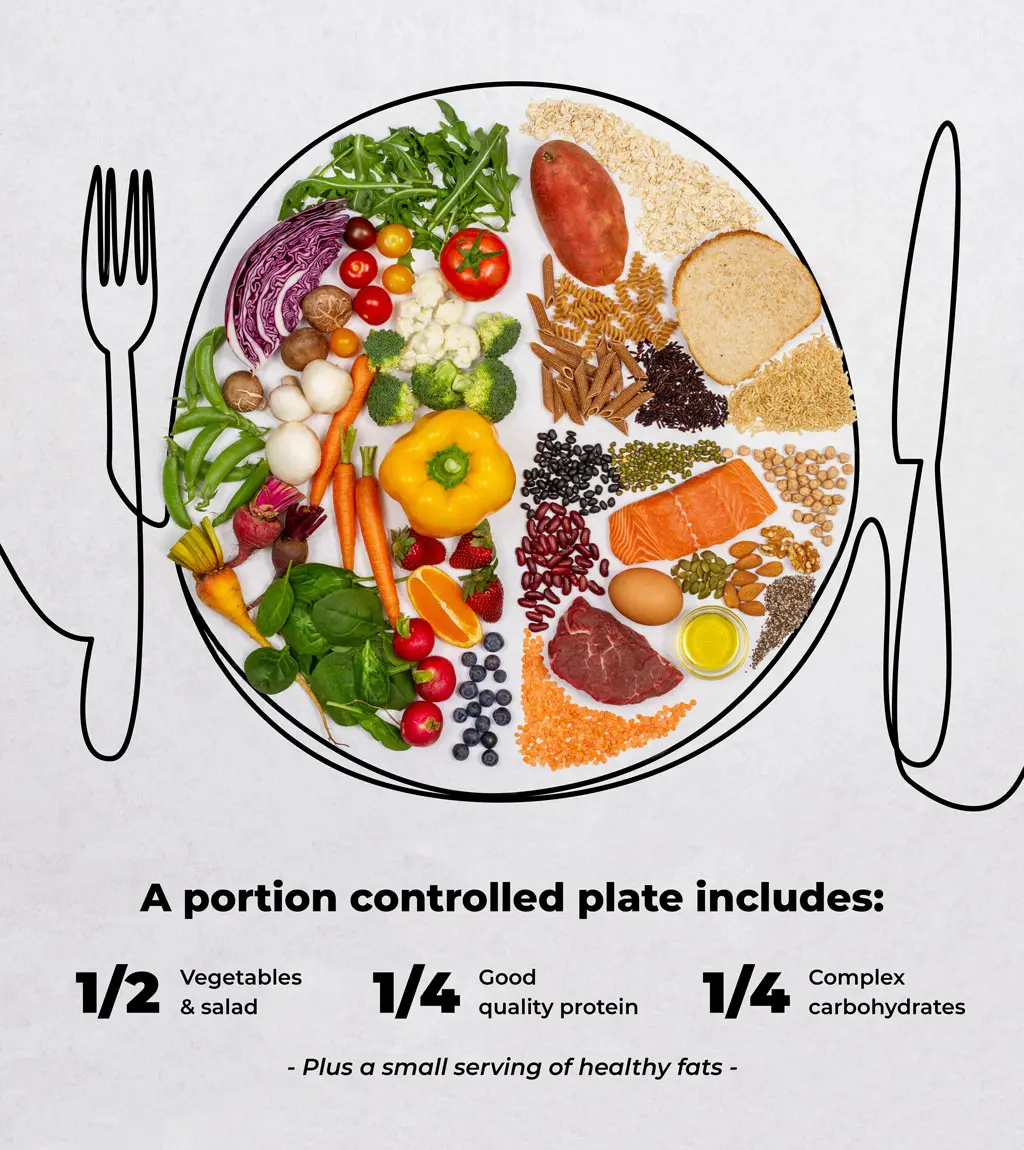An Everyday Guide To Portion Control

October 4, 2019

Portion control can help you achieve your healthy eating goals if you are trying to lead a healthier, more balanced lifestyle. It is important for making healthy eating choices that will provide you with energy to fuel your workouts and nutrients to help you feel and function at your best!
What is portion control?
According to the National Institute of Diabetes and Digestive and Kidney Diseases in the US, how much you eat is just as important as what you eat. Portion control is a great way to make sure you’re eating enough nutritious food — and aren’t overeating — while helping you reach your health and fitness goals.
Understanding portions means knowing how much to eat to feel satisfied and stay energised until your next meal. It’s different to a “serving” or “serving size”, which is the recommended amount of a specific food you should eat (more on this later).
When you become familiar with the correct portion size for you and your goals, you won’t need to measure your food servings at each meal — it takes practice, but eating the right amount will eventually become part of your daily habits.

Does portion control mean counting calories?
No! For some, when it comes to managing portion sizes, counting calories may help to support specific health and fitness goals (such as building muscle), but for most people, it isn’t necessary.
Instead, focusing on eating a balanced diet containing a range of carbohydrates, proteins and healthy fats is an effective way to ensure you are eating the right types, and amount, of foods.
According to Australia’s Heart Foundation, how much you eat, or your food portions, also contributes to eating well for your heart. Healthy food proportions can be measured out on your plate as a rough guide. Ideally, a portion-controlled plate will include the following food groups:
Around half of your plate should be filled with vegetables and salad
One quarter should contain good quality protein
The remaining quarter should contain complex carbohydrates and a small serving of healthy fats.
If you’re a member of Sweat, your daily meal plan follows the Australian Guide to Healthy Eating. This guide is based on the best available scientific evidence from around the world! Our recipes have been developed by a team of nutrition specialists, in consultation with the Sweat trainers, and are designed to provide you with nutritious foods each day from the five main food groups.
Remember flexibility is important in a sustainable approach to healthy eating — some days you will have more serves from a particular food group and other days you might have less. It helps to look at what you’re eating over a whole week, rather than a day or two.

How to figure out your correct portion sizes
Now you know how to portion your plate, the next step is to work out your portion sizes.
As mentioned earlier, a “serving size” can be defined as a measurement of different foods that have roughly the same amount of nutrients and energy. The serving size can be found on the Nutrition Facts label on most packaged foods.
A portion is the amount of food you eat for a meal or snack and will typically depend on how hungry you are or the type of meal you are eating.
For example, as stated by the Australian Government's Department of Health, a serving of grains is one slice of bread. If you’re eating a sandwich for lunch, you might have two slices, or two servings, of bread — this is your portion size.
Your ideal portion size will depend on a range of lifestyle factors including how active you are, and your health and fitness goals. Most countries have a set of defined Dietary Guidelines you can follow, including the Dietary Guidelines for Americans, The Eatwell Guide in the UK and the Australian Dietary Guidelines.
If you aren’t sure how much you should be eating, you can seek advice from a nutrition specialist, who can help you with an eating plan that meets your energy requirements. As you become more familiar with serving sizes and appropriate portions, you can make healthy food choices without needing to follow a prescriptive eating plan every day.
Tips for portion control
Many restaurants, cafes and food manufacturers have “up-sized” their servings, so knowing your portion sizes can help you to eat healthily without going hungry or overeating.
Here are some tips to help you choose the right portion sizes:
Use smaller dinnerware
Have you ever noticed that the plates used in cafes and restaurants are larger than the ones you use at home? If you’ve been brought up to clear your plate at every meal, this can lead you to eat more than you actually need.
Using smaller dinnerware at home can help you feel satisfied after eating a full plate of food.

Use your hands as a serving guide
Rather than carrying around cup measures and teaspoons, you can estimate a portion size based on your hand size. Your hand is proportional to your body, making this a useful guide. Many guidelines including the New Zealand Heart Foundation and The European Food Information Council (EUFIC) suggest:
Your palm is the size of a portion of good quality protein
Your fist is approximately the size of a portion of vegetables
Your cupped hand indicates a portion of carbohydrates
A portion of healthy fats should be the size of your thumb
Eat slowly and mindfully
According to Harvard’s School of Public Health, mindful eating can lead to improved psychological wellbeing, greater enjoyment when eating and help you to recognise when you’re feeling satisfied so you know when to stop eating.
Mindful eating involves removing distractions, such as the TV and slowing down your eating pace by putting down your cutlery, or sipping water between mouthfuls. This allows time for your body to give you feedback and let you know if you’re actually full.
Concentrate on how the food smells and looks, explore how it tastes and feels in your mouth, and how it feels in your stomach.
Start meals with a glass of water
Staying well-hydrated and starting each meal with a glass of water can help to curb thirst disguised as hunger.

Fill your plate once
Having shared plates on the table and buffet-style dining make it easy to continue filling your plate with the food that is available, and it can become easy to lose track of how much you’ve eaten.
When you serve yourself a meal, use a dinner plate and only fill it once, keeping your food proportions in mind to ensure you have included enough variety from each food group.
Include protein with every meal
A 2016 meta-analysis, “The Effects of Increased Protein Intake on Fullness” published in the Journal of the Academy of Nutrition and Dietetics found protein helps to increase fullness, so including this macronutrient with each meal can help you to feel satisfied and fuller for longer.
Don’t eat from the box or bag
If you’re eating packaged foods, don’t eat straight from the bag or box. Instead, check the recommended serving size and take out a portion. Alternatively, buy pre-portioned or single-serve packages.
Having a healthy mindset to nutrition means being flexible!
Understanding portion control is just one aspect of developing sustainable and healthy eating habits. With this knowledge, you can be comfortable eating in any environment, whether you’re cooking at home or at a special celebration dinner!
A balanced lifestyle means enjoying all kinds of food in moderation. Rather than categorising foods as “good” or “bad”, instead, view food as a source of nutrients and a central element of social connection — allow yourself to enjoy it.

A more empowered you starts with Sweat, and our editorial team is here to bring you the latest fitness tips, trainer recommendations, wellbeing news, nutritional advice, nourishing recipes and free workouts.
* Disclaimer: This blog post is not intended to replace the advice of a medical professional. The above information should not be used to diagnose, treat, or prevent any disease or medical condition. Please consult your doctor before making any changes to your diet, sleep methods, daily activity, or fitness routine. Sweat assumes no responsibility for any personal injury or damage sustained by any recommendations, opinions, or advice given in this article.
Nutrition